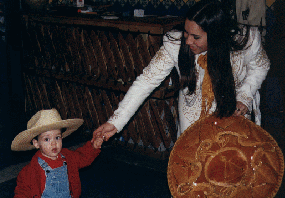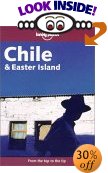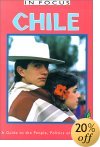
So you’re coming to Santiago!
Here are a few tips of places to see and things to do.
updated: Sunday, 22 October 2000
Restaurants and Nightlife
A great place to go for eating, dancing, etc. is an area called Bellavista (in Spanish, you pronounce the double l as a y - so ask for Beyavista, not Belavista).Restaurant prices range from very reasonable to very expensive, depending on the part of Bellavista and the restaurant you choose. There are cosy, reasonably priced restaurants. For example, the Libro Café which, if I remember correctly, is near the corner of Dardignac and Purisma streets. Here, one can get a plain but tasty and filling three course lunch for 1 800 pesos (very approximately R20 or US$3.50), which is good value for money, and I’ve heard it’s great at night too. There are also many pricier and more trendy restaurants in Bellavista - every type of food you can imagine. For example, a great restaurant where you cook your own food at the tables is Meridiano, at 185 Dardignac. These are just two examples of the many available options.
I’m not much of a clubber, but there are plenty of clubs, of all types of music, in Bellavista . You might want to try a salsa club for Latin dancing.
Museums
Santiago’s museums are a little disappointing. Possibly through no fault of their own - they are very obviously strapped for cash and this affects their product. Most information in museums is available in Spanish only, but if you are an English tourist, mention it. Some museums have supplementary carry-around material in English. If you have plenty of time and like museums, browse around and judge for yourself. If you are short of time, I recommend only two.You may have heard of a Chilean Nobel prize winning poet, called Pablo Neruda. He was an eccentric, a political exile for a while, and a collector of fascinating objects from all over the world. You can see some of his poetry here and here. If you’ve seen the Italian movie ‘Il Postino’ you will know exactly who I mean. He had a whole lot of houses and they are really fascinating places. One of them is in Bellavista, about 5 minutes walk from the Libro Café (see above), and well worth a visit. The address is Casa Matriz: La Chascona; Fernando Márquez de la Plata 0192; Providencia / Bellavista (the two areas overlap, I am not sure where the boundary between Bellavista and Providencia is). De la Plata is a tiny cul-de-sac filled with really old houses and ending in a tiny but beautiful plaza outside the museum. The closest Metro station is Baquedano. Walk straight up Pio Nono until you get to the intersection with Constitución, the site of a small park. Turn right, and walk a couple blocks - De la Plata is a small road leading off to your left. A point to note - the park at the intersection of Pio Nono and Constitución contains a small Artesanal (craft market) and the base of the Funicular which will take you to the top of Cerro San Cristobal (see hills, below).
And you must visit the Museo Chileno de Arte Precolombino. This is at Bandera 361, right in the center of town. (Remember that Spanish for downtown is “centro” - you will probably use this word a lot).
Sights in Santiago
Hills
Two hills that you must visit are Cerro Santa Lucia and Cerro San Cristobal.Cerro Santa Lucia is downtown - the closest metro station is "Santa Lucia". This is the hill where Santiago was founded in the fifteenth century - it has some fascinating 19th century ruins and a cannon which is shot every day at noon - don’t get a fright when you hear it. It is a very nice but steep walk - don’t wear slippery shoes. Also, be careful. I have had no problems, myself, but I have been warned that there are sometimes robberies on the hill. This hill is for a short visit only - maybe an hour.

Cerro San Cristobal is a must-see. It provides a magnificent view over the city of Santiago with the Andes in the background. It is topped by a chapel and a HUGE statue of the virgin - who watches over the city. There are rickety cable cars (telefericos) that take you up. It also has a small but pleasant Japanese garden, a larger but still rather small botanical garden, which is well worth a visit, and a zoo which I hear is not worth visiting. You can drive up the hill or walk - it’s a fair distance. Alternatively, you can take the Funicular, which leaves from near Pablo Neruda's house (see museums, above).

Plazas and parks
There are plazas and parks all over Santiago. There is a park which runs, at intervals, along the Rio Mapocho, a rather smelly river that runs through Santiago. The park is really pleasant, though. Try not to walk through the park looking like tourists with cameras and cash to steal - I’ve heard some stories about muggings there.One nice part of the park is on the north side of the river, where they have an enclosed section filled with sculptures and art work. There is no entry fee, but it does close at about 6.30 p.m. It is pleasant for a walk. The nearest metro station is Los Leones. A good idea is to get out at Los Leones station, buy some ice-cream at Freddo’s, and go for a nice stroll in the Parque de las Esculturas, looking at Chilean sculptures as you go.
Another part of the park includes the Palacio de Bellas Artes (Fine Arts) museum. Every Sunday evening, jugglers and other performance artists congregate in the park behind the museum. This part of the park is downtown, close to the Santa Lucia metro station and Cerro Santa Lucia, and is called Parque Forestal.
The main plaza of the city is Plaza de Armas - do NOT waste your time going there - for the present, it is a huge construction site - they are building a new metro line. The only reason you might want to go there is if you wish to visit the cathedral. But there are plenty of plazas scattered throughout the city - you are sure to come across them if you walk or drive around at all.
Short trips out of Santiago - one day to four days
Mas Mexico, and the Parque Nacional la Campana
Roberto, a born and bred Mexican and an enthusiastic cook, claims that the restaurant Mas Mexico provides the best Mexican food outside of Mexico! The downside is that the restaurant is about 90 minutes drive outside of Santiago. In my opinion, the best option is to make a day of it - drive on Route 5 to Mas Mexico for an early lunch, and then turn back towards Santiago and stop at the Parque Nacional la Campana for a pleasant afternoon of gentle hiking. Or, if you prefer not to walk on a full stomach, and I promise you, it WILL be full, you can do it the other way around.Mas Mexico is more than just an authentic Mexican restaurant. You enter by driving through an orchard of avocado trees, through the ruins of the oldest cement works in Chile and the owners' collection of rather dilapidated but interesting old vehicles, and then turn into a little dusty, one-street pueblo. Mas Mexico includes a large shop with goods from Mexico, a small chapel, and, of course, the restaurant. The restaurant has live Mexican music, and you're welcome to shout out requests - be sure to ask for El Rey. There is an extensive menu - I recommend that you start with the Sopa Azteca, and follow it with the Carnitas. And the margaritas are great! I've never had dessert there - I've always been too full.
Mas Mexico is at:
Fundo la Palmilla
Camino Internacional - KM 8
Tel: (33) 318 120
You can e-mail Mas Mexico at amed@entelchile.net.
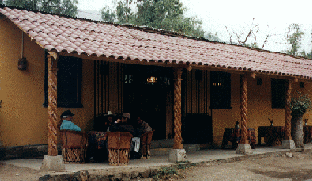
|
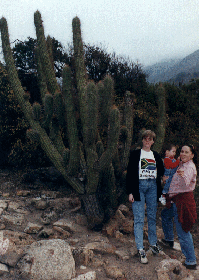
|
Viña del Mar and Valparaiso
Santiago is nicely placed between the mountains and the sea - as is all of Chile, in fact, its such a narrow country. The most popular beach destination is Viña del Mar (vineyard of the sea), which is about 2 ½ hours drive from Santiago.Viña is a very tourist-oriented place - beautiful beaches, although a little crowded, nice restaurants, etc. One can hire carriages or two person bicycles by the hour for beachfront rides, or simply stroll along, enjoying the view. There is also an incredibly beautiful park with a quite good fine arts museum and, sometimes, an artesanial (craft market).
Right alongside Viña is Valparaiso, which is Chile’s main port. The two towns have grown so that there is no gap between them, but their characters are very different. Valparaiso is a working town, grubby and dirty and in places dilapidated, but with beautiful old buildings. Another of Neruda’s houses is here. It is also a museum and is called Bellavista because of its beautiful view. There are also the famous Valparaiso elevators - very old cable car type vehicles which take you up the sides of the steep hills on which the town is built. A naval museum stands at the top of the only one I’ve ascended - not the greatest in the world ,but with possibly the most beautiful stained-glass windows I have ever seen.
Los Andes and Portillo - and, if you have enough time, on to Mendoza
One great day trip is to Portillo, a ski resort just before the Argentinean border.On the way from Santiago, one passes a huge sanctuary to Santa Teresa de Los Andes, who is Chile's only saint and very revered. It is worth stopping here for a while. One can see the chapel, her tomb, a small exhibition of her life and canonisation, and buy national artifacts and foods at stalls in the grounds. We stopped there in the spring, to see scores of Chileans flying kites with their children.
Then, drive a short distance on, to the town of Los Andes. This is a typical small Chilean rural town. Like most Latin American towns, it is centered on a very pleasant plaza, filled with people walking, sitting and socialising. We drove through the town, stopped to walk briefly in the plaza, and then went on - long enough to get a feel for the town and experience its atmosphere but, unfortunately, not long enough for me to be able to recommend particular sites to visit or things to do.
Then, on up into the Andes mountains - a long, curvy road up to the Portillo Ski Resort, with its lovely old-style hotel alongside a lake. This is a special place for me, as it is the first place in which I have ever been snowed upon :). The hotel is a great place to stop for a drink beside a roaring log fire, before driving back to Santiago.
If you have three or four days, you might wish to travel on into Argentina for a weekend in Mendoza. I highly recommend this trip. In fact, most foreigners staying in Chile visit Mendoza - if one doesn’t have a residence visa, it is necessary to leave the country every three to six months, and Mendoza is the closest, cheapest and possibly most pleasant way to do so. Enter here to read about our trip to Mendoza.
Read about some of our short trips outside Santiago - we used three to four days for each of these trips, but all could be extended to at least a week.
Easter Island, Chilean territory

Mendoza and surrounds, Argentina
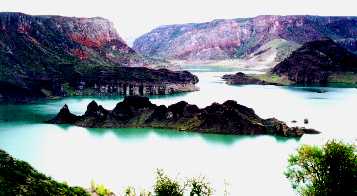
San Pedro de Atacama and surrounds, northern Chile
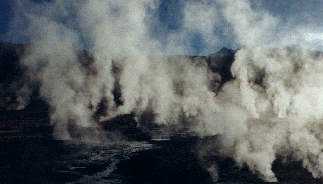
Lima and surrounds, Peru
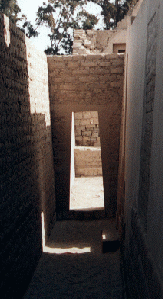
Useful Books from Amazon.com
I STRONGLY recommend the first two books, particularly, to all visitors to Chile, and especially to those gringos who are planning to settle in Chile for a while!
Quick travel:
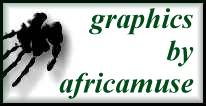

|

|

|
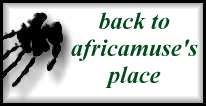
all original material (text, graphics, photographs and programming) © 1998-2006
Sally Smith
http://geocities.datacellar.net/africamuse
